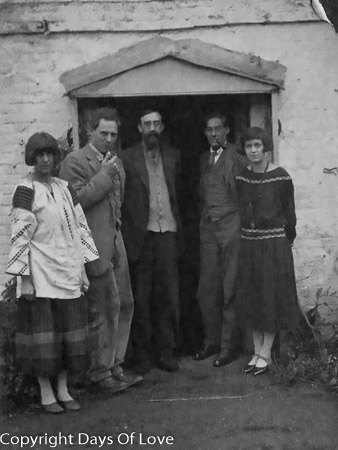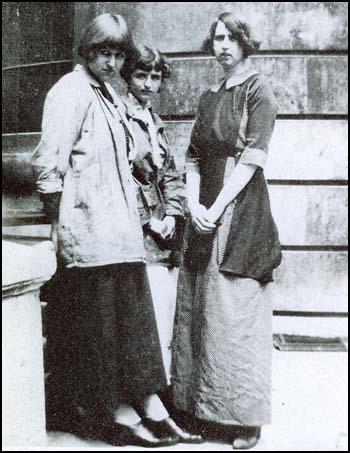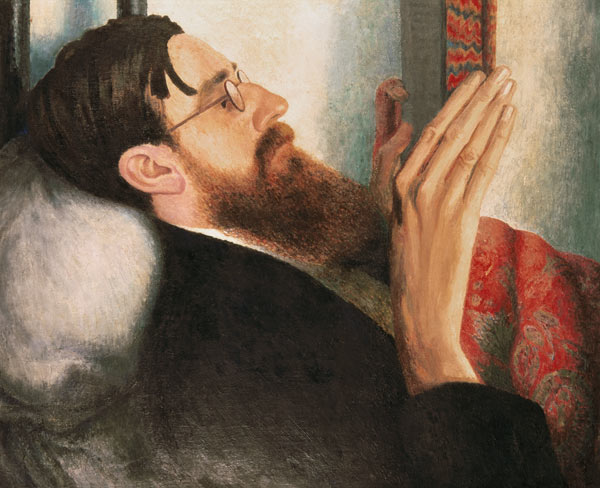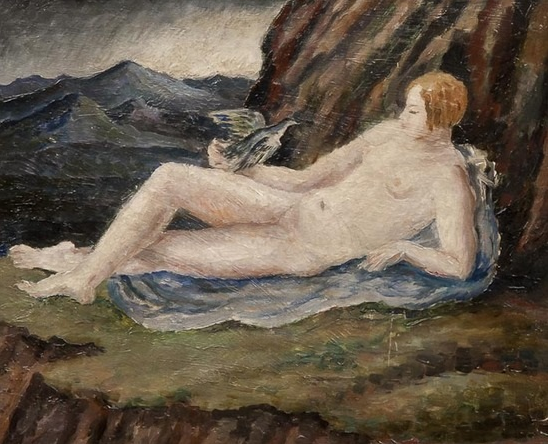Husband Ralph Partridge
Queer Places:
Bedford High School for Girls, Bromham Rd, Bedford MK40 2BS, Regno Unito
Slade School of Fine Art, University College London, Gower St, Bloomsbury, London WC1E 6BT, Regno Unito
The Mill, Tidmarsh, Reading RG8 8ER, Regno Unito
Ham Spray House, Marlborough SN8 3QZ, Regno Unito
 Dora
de Houghton Carrington (29 March 1893 – 11 March 1932), known generally as
Carrington, was a British painter and decorative artist, remembered in part
for her association with members of the Bloomsbury Group, especially the
writer Lytton
Strachey. She has been romantically linked to Lady Ottoline Morrell,
Henrietta Bingham.
Dora
de Houghton Carrington (29 March 1893 – 11 March 1932), known generally as
Carrington, was a British painter and decorative artist, remembered in part
for her association with members of the Bloomsbury Group, especially the
writer Lytton
Strachey. She has been romantically linked to Lady Ottoline Morrell,
Henrietta Bingham.
The daughter of a Liverpool merchant, she was born in Hereford, England,
and attended the all-girls' Bedford High School which emphasized art. Her
parents also paid for her to receive extra lessons in drawing. In 1910, she
went to the Slade School of Art at University College, London where she
subsequently won a scholarship; her fellow students included
Dorothy Brett,
Paul Nash, Christopher R. W. Nevinson and Mark Gertler. All at one time or
another were in love with her, as was Nash's younger brother John Nash, who
hoped to marry her.[1][2]
Gertler pursued Carrington for a number of years, and they had a brief sexual
relationship during the years of the First World War.[3]

Dora Carrington, Barbara Hiles and Dorothy Brett in 1911

Lytton Strachey by Dora Carrington, 1916
_Sprott;_Lytton_Strachey,_June_1926.jpg)
Lady Ottoline Morrell (1873–1938), vintage snapshot print/NPG Ax142600. Dora Carrington; Stephen Tomlin; Walter John Herbert ('Sebastian') Sprott; Lytton Strachey, June 1926

E. M. Forster 1920
Dora Carrington (1893–1932)
National Portrait Gallery, London

Reclinging nude with dove in a mountainous landscape (Portrait of Henrietta Bingham),
by Dora Carrington
David Boyd Haycock, the author of A Crisis of Brilliance (2009) has pointed
out that Brett became very close to Carrington and
Barbara Hiles while at the
Slade School. Brett and Hiles copied Carrington when in 1911 she cut her long
hair to a "short, boyish bob". They became known as the "Slade Cropheads" and
"set a trend for young female art students".
From her time at the Slade onwards, she was commonly known simply by her
surname. She was not well known as a painter during her lifetime, as she
rarely exhibited and did not sign her work. She worked for a while at the
Omega Workshops, and for the Hogarth Press, designing woodcuts.[4]
Carrington was not a member of the Bloomsbury Group, though she was closely
associated with Bloomsbury and, more generally, with "Bohemian" attitudes,
through her long relationship with the homosexual writer
Lytton Strachey,
whom she first met in 1916. Distinguished by her cropped pageboy hair style
(before it was fashionable) and somewhat androgynous appearance, she was
troubled by her sexuality; she is known to have had an affair with Henrietta
Bingham. She also had a significant relationship with the writer Gerald
Brenan. In his first novel Crome Yellow,
Aldous Huxley based
the character of Mary Bracegirdle on Carrington, and described how she and he
slept on the roof of "Lollipop Hall", based on Lady
Ottoline Morrell's home. He chose the name "Bracegirdle" because of Dora's
chastity.[5]
In June 1918,
Virginia Woolf wrote of Carrington in her diary: "She is odd from her
mixture of impulse & self consciousness. I wonder sometimes what she’s at: so
eager to please, conciliatory, restless, & active.... [B]ut she is such a
bustling eager creature, so red & solid, & at the same time inquisitive, that
one can’t help liking her."[6]
Carrington first set up house with Lytton Strachey in November 1917, when they
moved together to Tidmarsh Mill House, near Pangbourne, Berkshire. Carrington
met Ralph Partridge,
an Oxford friend of her younger brother Noel, in 1918. Partridge fell in love
with Carrington and eventually, in 1921, Carrington agreed to marry him, not
for love but to hold the menage a trois together.[7]
Strachey paid for the wedding, and also accompanied the couple on their
honeymoon in Venice. The three moved to Ham Spray House in Wiltshire in 1924;
the house had been purchased by Strachey in the name of Partridge.[8]
In 1926, Ralph Partridge began an affair with
Frances Marshall, and left to live with her in London. His marriage to
Carrington was effectively over, but he continued to visit her most weekends.
In 1928 Carrington met Bernard ‘Beakus’ Penrose, a friend of Partridge’s and
the younger brother of the artist Roland Penrose, and began an affair with
him. The affair energized Carrington's artistic creativity, and she also
collaborated with Penrose on the making of three films. However, Penrose
wanted Carrington exclusively for himself, a commitment she refused to make
because of her love for Strachey. The affair, her last with a man, ended when
Carrington became pregnant and had an abortion.
During her lifetime, Carrington's work received no critical attention. The
lack of encouragement may have kept her from displaying her artwork.
Carrington's work can be described as progressive, because it did not fit into
the mainstream of art in England at the time. In fact, her work was not
considered art at all. It featured Victorian-style pictures which were made
from coloured tinfoil and paper. Carrington included pen sketches in letters
to her friends, with the intention of entertaining them. She also created
woodblock prints, which were highly regarded. Her lesser-known work included
painted pub signs and murals, ceramics, fireplaces, and tin trunks.
Carrington was better known for her landscape paintings, which have been
linked to surrealism. Her landscapes blend the facts of visual perception with
interior desires and fantasies. One work of art, Mountain Ranges from
Yegen, Andalusia, 1924, shows the split in perspectives. There is an
intimate foreground, and there is in the distance a view of the mountains. The
main focus, on the middle mountains, exhibit the texture of human skin. This
merges the notion of the personal being made public.[9]
Lytton Strachey died of stomach cancer at Ham Spray in January 1932.
Carrington, who saw no purpose in a life without Strachey, committed suicide
two months after his death by shooting herself with a gun borrowed from her
friend, Hon.
Bryan
Guinness (later 2nd Baron Moyne).[10]
Her body was cremated and the ashes buried under the laurels in the garden of
Ham Spray House.[11]
An accomplished painter of both portraits and landscape, she also worked in
applied and decorative arts, painting on any type of surface she had at hand
including inn signs, tiles and furniture. She also decorated pottery and
designed the library at Ham Spray. In 1970
David Garnett
published a selection of letters and extracts from her diary, since which time
critical and popular appreciation of her work has risen sharply.[12]
In 1978, Sir John Rothenstein, for nearly thirty years Director of the Tate
Gallery, London, called Dora Carrington "the most neglected serious painter of
her time."[13]
"That is no longer the case. In 1995 she was the subject of a major
retrospective exhibition at the Barbican Art Gallery in London."[14]
Two of her works are in the Tate Gallery, London.[15]
Carrington's life with Strachey was dramatized in the 1995 biographical
film Carrington, starring Emma Thompson in the title role.
For many years, Carrington’s art was neglected by the public and her main
notoriety was due to her relationship with
Lytton Strachey.
On the day she agreed to marry Partridge she wrote to Strachey, who was in
Italy, what has been described as "one of the most moving love letters in the
English language".[16]
She wrote "... I cried last night Lytton, whilst he slept by my side sleeping
happily—I cried to think of a savage cynical fate which had made it impossible
for my love ever to be used by you ..." Strachey wrote back "... you do
know very well that I love you as something more than a friend, you angelic
creature, whose goodness to me has made me happy for years, and whose presence
in my life has been and always will be, one of the most important things in my
life ..."[17]
On his deathbed Strachey said, "I always wanted to marry Carrington and I
never did." His biographer calls this sentiment "not true; but he could not
have said anything more deeply consoling".[18]
Upon his death, Strachey left Carrington £10,000 (the equivalent of £240,000
in 1994).[19]
She is also connected with Elizabeth
McCausland.
My published books:


BACK TO HOME PAGE
-
"Dora Carrington: a difficult virus to get out of your system".
Independent. 23 October 1999.
Retrieved 7 November 2017.
-
"Dora Carrington :: Biography (1893-1932) :: Gallery :: Canvas Prints".
www.leninimports.com. Retrieved
2018-01-15.
-
Dora Carrington – an outline of her life - painter, designer, bohemian,
bisexual
-
"Dora de Houghton Carrington: An Inventory of Her Collection at the Harry
Ransom Humanities Research Center". norman.hrc.utexas.edu.
Carrington, Noel, Gertler, Marjorie, Gertler, Mark, 1891-1939, John,
Augustus, 1878-1961, Lamb, Henry, 1883-1960, Nevinson, C. R. W.
(Christopher Richard Wynne), 1889-1946.
Retrieved 2018-01-15.
- "The Art of Dora
Carrington" by Jane Hill, chapter 3.
- Ann Olivier Bell (ed.)
(1977), The Diary of Virginia Woolf, Vol. I: 1915—1919 (London: The
Hogarth Press), page 153.
- "Lytton
Strachey: The New Biography" by Michael Holroyd, 1994, p.485
- "Carrington--A Life" by
Gretchen Holbrook Gerzina, 1989, p. 299.
-
Elinor, Gillian (Spring–Summer 1984).
"Vanessa Bell and Dora Carrington:Bloomsbury Painters". Woman's Art
Journal. 5 (Woman's Art Inc.): 28–43.
JSTOR 1357882.
- Haycock, A Crisis of
Brilliance, p. 313
-
"Dora Carrington (1893 - 1932) - Find A Grave Memorial".
Findagrave.com. Retrieved
2014-04-17.
- "Carrington--A Life" by
Gretchen Holbrook Gerzina, 1989, Introduction p. xv.
- Noel Carrington,
Carrington Paintings, Drawings, and Decorations [1978], p. 14
-
"Dora Carrington". Davis & Langdale Company, Inc.
Retrieved 2014-04-17.
-
"Art and artists: Artworks". Tate.
Retrieved 2014-04-17.
-
French, Sean (28 August 1994).
"For consenting adults: 'Lytton Strachey: The New Biography' - Michael
Holroyd". London: The Independent.
Retrieved 15 February 2011.
- "Lytton Strachey--The
New Biography" by Michael Holroyd, 1994, p.486–487
- "Lytton Strachey--The
New Biography" by Michael Holroyd, 1994, p.678
- "Lytton Strachey--The
New Biography" by Michael Holroyd, 1994, pp.686, 531.
 Dora
de Houghton Carrington (29 March 1893 – 11 March 1932), known generally as
Carrington, was a British painter and decorative artist, remembered in part
for her association with members of the Bloomsbury Group, especially the
writer Lytton
Strachey. She has been romantically linked to Lady Ottoline Morrell,
Henrietta Bingham.
Dora
de Houghton Carrington (29 March 1893 – 11 March 1932), known generally as
Carrington, was a British painter and decorative artist, remembered in part
for her association with members of the Bloomsbury Group, especially the
writer Lytton
Strachey. She has been romantically linked to Lady Ottoline Morrell,
Henrietta Bingham.

_Sprott;_Lytton_Strachey,_June_1926.jpg)


